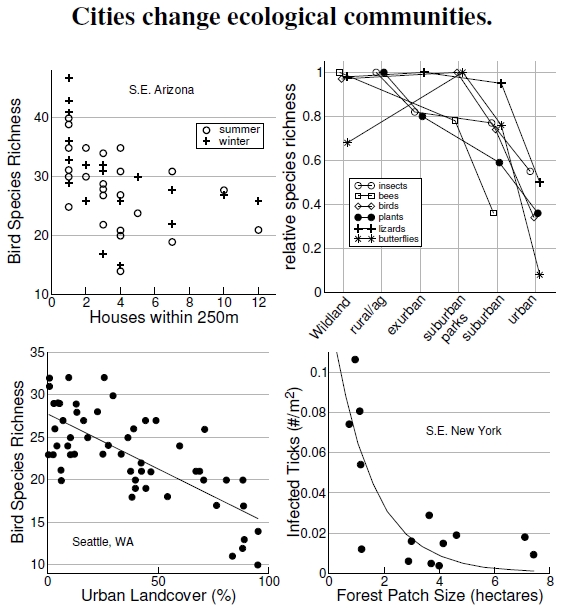1. 8 Urban Species
 Figure 1.8: Bird species richness decreases with the number of houses in southeastern Arizona (after Bock et al. 2008). Relative species richness of many organisms, sampled over several regions of the United States, decrease with increasing urban land use (after Hansen et al. 2005). In Seattle,Washington, bird species richness decreases drastically with increasing urban landcover over 1 km2 areas (after Donnelly and Marzluff 2006). Habitat fragmentation associated with urbanization creates small forest patches, which hold a greater abundance of ticks infected with the bacterium causing Lyme disease (after Allan et al. 2003).
Figure 1.8: Bird species richness decreases with the number of houses in southeastern Arizona (after Bock et al. 2008). Relative species richness of many organisms, sampled over several regions of the United States, decrease with increasing urban land use (after Hansen et al. 2005). In Seattle,Washington, bird species richness decreases drastically with increasing urban landcover over 1 km2 areas (after Donnelly and Marzluff 2006). Habitat fragmentation associated with urbanization creates small forest patches, which hold a greater abundance of ticks infected with the bacterium causing Lyme disease (after Allan et al. 2003).
Land-use change affects animals and plants, too, and, not surprisingly, denser cities harm ecological communities more (Figure 1.8). Exurban areas in Sonoita Valley in southeastern Arizona are sparsely populated “suburbs” with house densities averaging one house per 5.2 hectares (about 13 acres) with small commercial centers.[35] In these areas, researchers counted birds on 48 transects covering 480 square kilometers, with each transect sampled 29 times, roughly balanced between winter and summer. The upper left graph of the figure plots bird species counted against the number of homes within 250 meters of the transect’s midpoint. Interestingly, more bird species were found in exurban housing developments than on undeveloped ranch land, and, surprisingly, more birds were found on grazed than ungrazed lands. Water availability likely explained both of the patterns: It takes just a few ranch houses to provide water to birds, and beyond that, birds dislike more houses.
At top right, a compilation of studies across the United States indicate similar patterns across organisms ranging from insects to plants to lizards. Generally, “wild” places and rural areas show the greatest species diversity, while urban areas are relatively depauperate.[36] Overall, highly urban areas possess just 10 to 50% of the species found in the most species-rich areas.
In Seattle, Washington, a variety of sites were chosen along a gradient of urban land cover, averaged over more than 50 distinct square kilometer quadrats.[37] Birders performed bird species counts at these sites and found a remarkable decrease in species richness, shown at bottom left, from about 25–30 in forested sites, down to 15–20 species in mostly urban areas.
An even more complicated scenario exists with ticks and Lyme disease, shown at bottom right. The conversion of land into housing developments leads to forest fragmentation, and fragmentation causes all sorts of upset ecological interactions. Lyme disease in people results by infection with Borrelia burgdorferi, a bacterium transmitted by the tick, Ixodes scapularis. This tick loves mammals, birds, and reptiles, with its juvenile stages having been reported on more than 100 different host species.[38] Juvenile (nymphal) ticks get infected by the bacterium when they take a blood meal from an infected host individual, but host species differ in how likely the bacterium gets transmitted to the baby tick.[39] White-footed mice make great hosts from the bacterium’s perspective, transmitting the bacterium to the tick around 6 times out of 10 blood meals. Habitat fragmentation comes in because the white-footed mouse wins the ecological competition against other species in small forest patches. The mouse wins, the tick probably doesn’t mind, the bacterium certainly wins, and urbanites get Lyme disease.
——————————
[35]Bock et al. (2008) studied bird species richness in southeastern Arizona.
[36]Hansen et al. (2005) compiled the cross-taxa surveys of species richness versus land-use types. Richness values are measured relative to the highest observed species richness across all of the listed land-use types.
[37]Donnelly and Marzluff (2006) performed an extensive study of bird species richness in Seattle, Washington.
[38]Ostfeld and Keesing (2000) provide a wonderful overview of the ecology surrounding Lyme disease and cite 10,000–17,000 cases reported in the United States in the 1990s. Allan et al. (2003) provide the data regarding infected ticks with forest patchiness.
[39]These ticks go by a common name, deer ticks, because the adult tick often takes its final blood meal from a white-tailed deer, but by no means does it only parasitize deer.